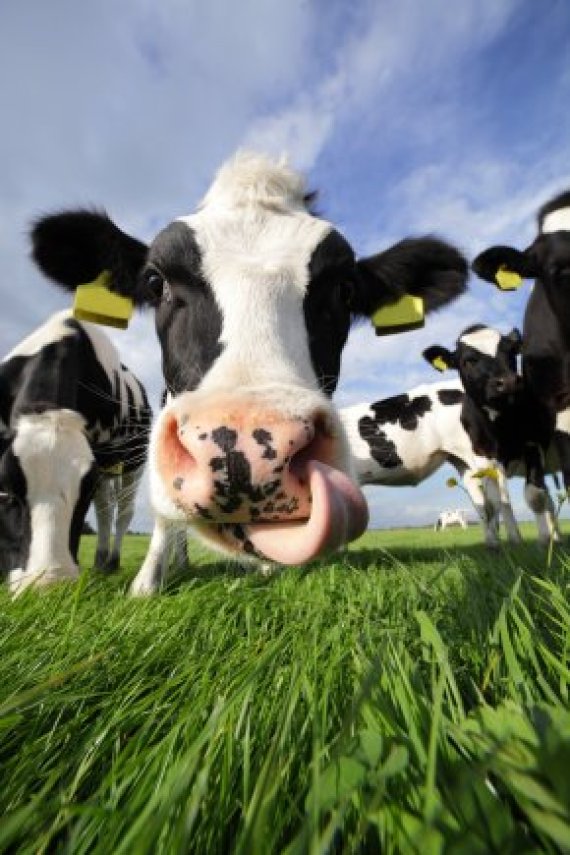Photos: Veeteelt, Shutterstock & Inke Fiona Cnossen
If you Google ‘Dutch cows’ you’ll find a motley collection of photos of cows in green meadows, their noses just a bit too close to the lens, and a blue sky with fluffy white clouds in the background. An iconic image of traditional Holland. Or is it? Most of these ladies are Holstein-Friesians, an originally American breed descended from Dutch Friesian cattle.
It all started in the 19th century when an American sea captain docked in Amsterdam harbour bought a black and white cow to provide his crew with milk on board ship. The cow carried on producing milk even after the Atlantic crossing and the Americans were very impressed. It didn’t take long before ships laden with thousands of Dutch cows were setting sail for the land of opportunity. ‘The Americans selected the best milk cows for further breeding,’ says Sipke Joost Hiemstra, director of the Centre for Genetic Resources, the Netherlands (CGN) at Wageningen University & Research. ‘And so a new breed developed, the Holstein-Friesian: now the most productive dairy cow in the world.’ Today more than 99 percent of Dutch dairy cows are Holstein-Friesians and this champion milk producer’s picture adorns all Friesland-Campina packaging. Meanwhile you see fewer and fewer specimens of the real old Dutch cattle breeds. So which are those breeds, actually? A brief round of introductions:
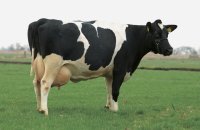
Dutch Friesian
Status: threatened, trend: falling, numbers: 1621*
Although in 1975 the Dutch Friesian cow was still the dominant breed in the Netherlands, there are now fewer than 2000 female breeding animals in the country. Whereas in the US the descendants of the original Dutch Friesian cattle were bred over many generations for milk production, here in the Netherlands there was more emphasis on appearance and the cows became smaller and smaller. The famous Ús Mem statue in Leeuwarden is of a Dutch Friesian cow.
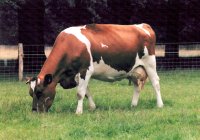
Red and White Friesian
Status: threatened, trend: growing, numbers: 520*
The Red and White Friesian is a breed which should, officially, be extinct by now. In the Middle Ages most Dutch beef cattle were red and white but after an outbreak of rinderpest and floods around 1750, new black and white cows were imported from Denmark and Germany. In the Dutch beef cattle breed registry established in 1874, three cattle breeds were recognized: the black and white Dutch Friesian cow, the red and white Maas-Rhine-Ijssel cow, and the Groningen White-Headed cow. No other breeds could be registered for breeding. But a number of farmers kept a Red and White Friesian bull in a barn so the breed continued to exist.
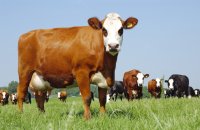
Groningen White-Headed
Status: threatened, trend: stable, numbers: 2190*
The White-Headed cow is all black or red with a white head and tail tip. It gets dubbed the ‘polder panda’ because of the characteristic rings around its eyes, and its rarity. This is an old breed which was described as long ago as the 14th century, before there were official breeds. The White-Headed cow is known for its strong legs, great fertility, good-quality meat and low-maintenance robustness.
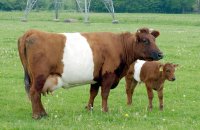
Dutch Belted
Status: threatened, trend: stable, numbers: 1600*
The Dutch Belted cow is an old breed, described as far back as the 12th century. The breed owes its name to the band of white around its middle. Because Dutch Belted cows were originally owned by nobility they were known as ‘castle’ or ‘park’ cattle. When the castles and estates largely disappeared, the Dutch Belted cow became a threatened breed and at its lowest point there were only about 300 specimens left in the Netherlands. Numbers have now recovered and the breed is gaining popularity, not least because of its unusual appearance.
 ## Meuse-Rhine-IJssel (MRIJ)
## Meuse-Rhine-IJssel (MRIJ)
Status: normal, trend: falling, numbers: 15,567*
This red and white breed developed on the fertile plains between the Maas, Rhine and Ijssel rivers. These cows produce less milk than Holstein-Friesians, but the protein content of their milk is higher, so it is worth more. This is a strong, calm, low-maintenance cow. In the 1960s and 70s, half of all Dutch cattle were MRIJ, but after that their numbers went into a steep decline. With the introduction of milk quotas in 1984, they became more interesting economically, and details from accountants’ firms show that farmers could make a good living from this robust dual-purpose breed.
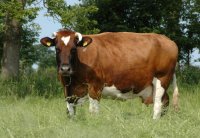
Deep-Red Cattle
Status: threatened, trend: growing, numbers: 941*
This breed was named for its dark reddish, in places almost blackish colour. Its lower legs, belly and tail tip are white. The Deep-Red cow is strong, long-lived and fairly winter-hardy. It is therefore suited to grazing in nature areas. One company makes a special, hard and nutty-tasting ‘Deep-Red’ cheese from its milk. This is one of the few breeds that is growing in numbers, although it is still on the threatened list.
In contrast to the specialized Holstein-Friesians, the original old Dutch cattle breeds are what is known as dual-purpose breeds, which is to say that they are suited to both dairy and beef production. Although they produce less milk than the Holstein-Friesian, these old breeds can fend for themselves better, says Hiemstra, and they do well on more extensive farms or with an element of nature reserve grazing. Besides, they are part of our living cultural heritage and we should look after that diversity.
You can find more information about more cattle breeds on http://efabis.cgn.wur.nl/.
*EFABIS database, data from 2014. Threatened means there are less than 3000 female breeding animals.

